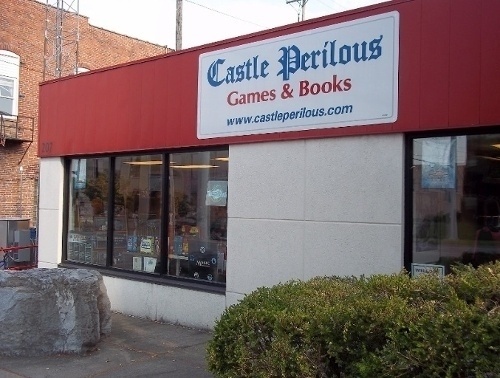Well, first of all, unless your company has prepared extremely well and has some great opportunities come its way (luck is what happens when preparation meets opportunity), your new game has to stand out among some 200 new releases hitting the shelves every month. The brick and mortar game store does several things for your game that an online stock cannot: lets people touch the game, gives them the opportunity to try out the game and, assuming the game company and game store have prepared properly, has people on hand to explain the mechanics of the game and why it would fit the customer’s particular gaming wants.
However, if your company has the money, or a little extra time and some graphic design capability, there are some things you can do to make it easier for us to sell your game.
- QR Code on the box. This one is fairly easy to incorporate into your original package design, although the use of QR codes has waned quite a bit in popularity since their peak in popularity about a decade ago when every print advertisement had a QR code embedded in it and still assumed that potential customers had downloaded scanning aps to their smart device and, more importantly, remembered to use them. Still, linking a package QR code to a short (emphasis on short: 1-2 minutes is about the most you can expect a customer to stand there) video either showing how cool the game contents look or a quick look at how it plays.
- Shelf Talkers. A shelf talker is that little piece of cardstock that hangs over the lip of a shelf below the product (in this case a game) that it advertises. By breaking up the "flow" of the shelf, it draws the eye’s focus to it and attracts attention, which is what you want to accomplish. If you can fit the information on it, a brief description of the game or a quick explanation of why this game is so cool helps sell it. Additionally, as with the QR code on the box, putting a QR code on the shelf talker linked to a short promotional video is a plus. Unfortunately, shelf talkers tend to get torn, lost or otherwise have a short shelf life so either providing several replacements sent to the store (generally guaranteeing their use if possible) or digital materials (FAR less expensive for the publisher but also far less likely to get used) to download and print out as needed really helps.
- Advance or demo copies. Probably the best way to really get stores excited about your game is putting a shiny new copy in our hands. Most of the time, demo games come as part of a "Buy X, get one free," with the statement or inference that the store should use the game to demonstrate gameplay, thus selling more copies. Great in theory but often the demo game arrives with the regular order and the store gets busy putting the game on the shelf, and plans to learn and demo the game, while well intentioned, get put aside, with an open copy put out for customers to look through. It would really help us to sell your game better if we got in the free/demo copy 2-4 weeks ahead of time so we could look through it, learn it and talk knowledgably about it to the customer to gin up their interest. If this is logistically difficult, allow stores to pre-order a single copy of the game, either for free or at a steep discount (after all, we are using it to sell more copies of the game), possibly contingent on agreeing to purchase a given quantity of the game upon release.
There are a lot more ways, both pricy and cheap, or even free, publishers can do to help us move more copies of your games and I will discuss more in a future column. Feel free to contact me at castleperilousgames@gmail.com with any ideas you might have.
The opinions expressed in this column are solely those of the writer, and do not necessarily reflect the views of the editorial staff of ICv2.com.




